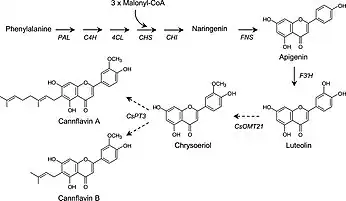Cannflavin
Cannflavins are a group of chemical compounds found in Cannabis sativa.[1] Chemically, they are prenylflavonoids and are unrelated to THC and other cannabinoids. Cannflavins A and B were first identified in the 1980s and cannflavin C was identified in 2008.[2]
 Cannflavin A | |
 Cannflavin B | |
| Names | |
|---|---|
| IUPAC names
6-[(2E)-3,7-Dimethylocta-2,6-dienyl]-5,7-dihydroxy-2-(4-hydroxy-3-methoxyphenyl)chromen-4-one (A) 5,7-Dihydroxy-2-(4-hydroxy-3-methoxyphenyl)-6-(3-methylbut-2-enyl)chromen-4-one (B) | |
| Identifiers | |
| |
3D model (JSmol) |
|
PubChem CID |
|
| UNII | |
| |
| Properties | |
| C26H28O6 (A) C21H20O6 (B) | |
Except where otherwise noted, data are given for materials in their standard state (at 25 °C [77 °F], 100 kPa).
Infobox references | |
Because cannflavins A and B are inhibitors of prostaglandin E2 production in vitro,[1][3] the cannflavins have been studied for their potential use as anti-inflammatory agents.[4]
Biosynthesis
Cannflavins A and B are biosynthesized by prenylation of chrysoeriol.[5]

Biosynthetic pathway of cannflavins.[6]
References
- Barrett, M. L.; Scutt, A. M.; Evans, F. J. (1986). "Cannflavin A and B, prenylated flavones from Cannabis sativa L". Experientia. 42 (4): 452–453. doi:10.1007/BF02118655. PMID 3754224. S2CID 19652191.
- Radwan, Mohamed M.; Elsohly, Mahmoud A.; Slade, Desmond; Ahmed, Safwat A.; Wilson, Lisa; El-Alfy, Abir T.; Khan, Ikhlas A.; Ross, Samir A. (2008). "Non-cannabinoid constituents from a high potency Cannabis sativa variety". Phytochemistry. 69 (14): 2627–2633. doi:10.1016/j.phytochem.2008.07.010. PMC 4888767. PMID 18774146.
- Barrett, M.L.; Gordon, D.; Evans, F.J. (1985). "Isolation from cannabis sativa L. Of cannflavin—a novel inhibitor of prostaglandin production". Biochemical Pharmacology. 34 (11): 2019–2024. doi:10.1016/0006-2952(85)90325-9. PMID 3859295.
- Oliver Werz; Julia Seegers; Anja Maria Schaible; et al. (July 2014). "Cannflavins from hemp sprouts, a novel cannabinoid-free hemp food product, target microsomal prostaglandin E2 synthase-1 and 5-lipoxygenase". PharmaNutrition. 2 (3): 53–60. doi:10.1016/J.PHANU.2014.05.001. ISSN 2213-4344. Wikidata Q114911513.
- Kevin A Rea; José A Casaretto; M S Al-Abdul-Wahid; Arjun Sukumaran; Jennifer Geddes-McAlister; Steven J Rothstein; Tariq A Akhtar (28 May 2019). "Biosynthesis of cannflavins A and B from Cannabis sativa L". Phytochemistry. 164: 162–171. doi:10.1016/J.PHYTOCHEM.2019.05.009. ISSN 0031-9422. PMID 31151063. Wikidata Q92444776.
- Kevin A Rea; José A Casaretto; M S Al-Abdul-Wahid; Arjun Sukumaran; Jennifer Geddes-McAlister; Steven J Rothstein; Tariq A Akhtar (28 May 2019). "Biosynthesis of cannflavins A and B from Cannabis sativa L". Phytochemistry. 164: 162–171. doi:10.1016/J.PHYTOCHEM.2019.05.009. ISSN 0031-9422. PMID 31151063. Wikidata Q92444776.
This article is issued from Wikipedia. The text is licensed under Creative Commons - Attribution - Sharealike. Additional terms may apply for the media files.